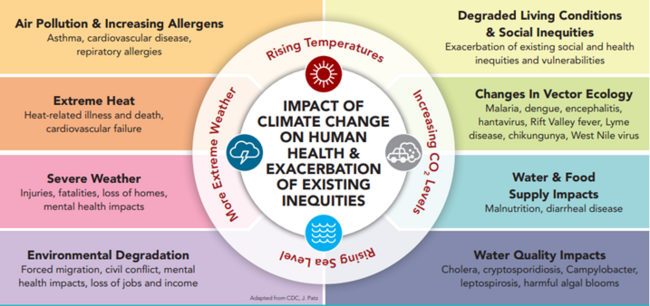Certain People are More Affected by Climate Change
Climate change affects everyone's health, but certain people are more affected than others.
In Vermont, people and communities most affected by climate change also experience health inequities. Examples of the groups that are disproportionately affected by the health impacts of climate change include:
- Low-income individuals and families
- Immigrants, especially those with undocumented status
- Outdoor workers, like farm workers and road crews
- Unhoused people
- Older adults
- People living alone
- People with existing health conditions, such as chronic diseases and mental health problems
- People living in floodplains
Some people are more exposed to climate-related health impacts. For example, people who work outside, are unhoused, or live in floodplains experience greater health risks from flooding and heat.
Some people may have increased health risks due to age (for example, older adults, babies, and children), having a chronic or pre-existing medical condition, or taking certain medications.
Even people in good current health but lacking economic, social, or political resources may have less ability than others to reduce their risks, prevent impacts from happening, and recover from impacts when they do happen. For example, a home-bound older adult living alone may be especially at risk during a heat wave or extreme weather event. Learn more about how climate change affects health
Climate Change Worsens Existing Inequities
Climate change and health inequities share similar root causes: the inequitable distribution of social, political and economic power. These power imbalances result in systems (economic, transportation, land use, housing, education and more) and conditions that drive both health inequities and greenhouse gas emissions.
Communities with inequitable living conditions, such as historically marginalized and under-resourced communities (for example, Black, Indigenous, Refugee, Immigrant and others) live in more polluted areas and face climate change impacts that compound and worsen existing health inequities.

(This section is adapted from the California Department of Public Health.)
Resources for Those Who Can Impact Change
Below are resources to help you learn more about how to identify and help affected populations. Learn more about environmental justice and public health
| Resource | Description |
|---|---|
| Climate Change and Human Health: Who's Most at Risk? | This page from the Environmental Protection Agency (EPA) outlines how climate change affects the health of specific populations, including children, indigenous people, those with chronic medical conditions or disabilities, workers and pregnant people. |
| Tools for Community Planners | Tools to help planners understand community-level strengths and vulnerabilities, including the Vermont Social and Heat Vulnerability Indexes. |
| Assessing Health Vulnerability to Climate Change: A Guide for Health Departments | This guide uses the Centers for Disease Control and Prevention's Building Resilience Against Climate Effects (BRACE) framework to help health departments prepare for and respond to climate change. |
| Climate Change and Health Playbook | The Climate Change and Health Playbook: Adaptation Planning for Justice, Equity, Diversity and Inclusion is designed to support the work of state, local, territorial and tribal health services across the nation in embedding justice, equity, diversity and inclusion into their climate and resilience initiatives, programs and operations. |
| Assess Vulnerability & Risk | This resource from the U.S. Climate Resilience Toolkit presents a plotting tool to characterize risk and help communities come to a decision point. |
| Climate Change, Health, and Equity: A Guide for Local Health Departments | The guide includes overviews of climate science, health impacts of climate change and how health equity fits into the equation. |
| Community Resilience Assessment | This assessment from Community Resilience Organizations has you score factors of resilience across five main topics to help you understand your community's vulnerabilities and strengths. |
